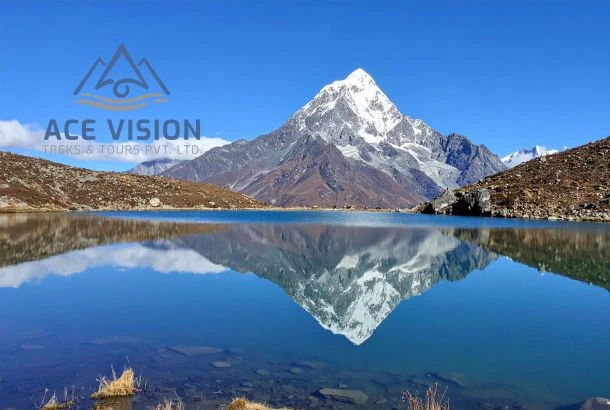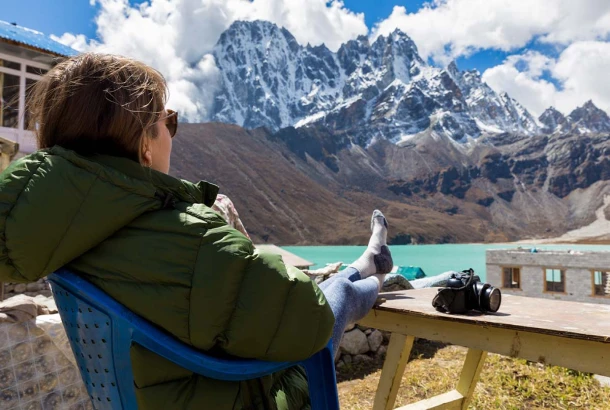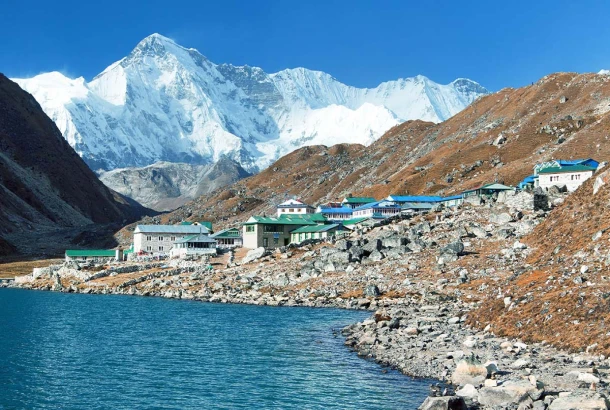Mani Rimdu during Everest Base Camp Trek in Autumn Season
Ever wondered what kind of rituals Mountain people perform? Trek is not just about adventure. There is more to it. To know what’s more try trekking to Everest base camp during autumn.
As autumn is the festive season the trekking experience is more inspiring and better. Sense, the change in the eyes of the locals along the trail. Feel the aura of hope, excitement, encouragement, and happiness through the eyes of Everest people in autumn.
Feel the awakening energy amongst the locals. You have heard about Dashain and Tihar in Nepal, but did you ever hear about Mani Rimdu?
The religion, spiritual beliefs, and culture of the locals are mainly reflected by rituals they perform. Mani Rimdu is the main event of the Khumbu people held during October/November. It is a 19-day festival where spectacular performances are performed by the Khumbu people drawing everyone’s attention.
Mani Rimdu is performed to show gratitude to the founder of Tibetan Buddhism, Guru Rinpoche. The event is held in 3 monasteries, Tengboche, Thame, and Chiwong monastery in the Khumbu region. Autumn trekking offers a beautiful opportunity to feel the magic Mani Rimdu brings to Everest.
The origin of Mani Rimdu is the Rongbuk monastery in Tibet. First monastery to adopt the event from Nepal is Tengboche Monastery. The main event is held in Tengboche monastery which is the oldest monastery in Everest region.
During the event, masked dances, dramas, and continuous chants of mantras are done. Trekkers are allowed to participate in their presentations, which is entertaining: witness, the respect and love of the Khumbu people towards their tradition during the trek.
The continuous flapping of the prayer flags, chants of mantras, spiritual dance, and the gathering feels like entering a different world. If you want to explore more than just the trails leading to base camp, you should trek in the autumn season.
The choice is yours to make!

What to expect during Everest Base Camp Trek in Autumn Season?
Stable weather condition
Autumn is well known for its stable and pleasant weather conditions. Temperatures are not excessively cold or hot during autumn. It is like the silence after the great thunder. Mountains are washed by the rainy season which gives stunning clear Mountain View.
Witness the pure art of sunshine and sunset with clear sky during autumn. See the morning start with a golden ray touching the great Himalayas and the sun-kissed goodbye at the end. Enjoy a fantastic view from Kalapatthar during Everest base camp trekking in clear weather of autumn.
Temperature of autumn
In Nepal, autumn starts in September and ends in November.
- September is the starting month of the autumn season. Light rains are expected in September. The temperature in Everest region during September ranges from 3 degrees to -13 degrees.
- October is the most crowded month as the weather is stable and there is a very low chance of rain. The weather is very adaptable and temperature in Everest region during October ranges from 10 to -5 degrees.
- November is the last month of autumn season. The crowds are less during the month. The temperature during November ranges from 5 to -12 degrees. For detailed information: weather and temperature of Everest trek month-wise
Meet new Himalayan friends on the way
Autumn is a popular season to trek, it brings many trekker friends to join the adventure. During your Everest base camp trek in autumn season, you can see and meet new trekkers.
If you are performing a solo trek, you have a good opportunity to make new friends.
Everest trek in autumn can be very satisfying if you love enjoying group adventures. The trails are not as quiet and everyone exchanges friendly greetings to each other. Trekking becomes less awkward. Enjoy group activities together and have new experiences with new friends.
There is less chance of getting lost as most of the trekkers have same destination to reach. When there are many trekkers, help is always around. Trekkers can Share charging utilities, drinking water, and first aid when needed. The trekking is less scary in autumn, and less lonely.
Clear mountain views
Witness, the hiding mountains glowing once again. See, a glow of the mountains that rain leaves behind.
Warm sun kissing your face, cool air touching your skin, trees dancing and wherever you go mountains whisper, come closer. Forget about all your struggles to keep up during the trek with clear visibility of the mountains.
Get a close-up view of many mountains along the way like, Lhotse, pyramid Nuptse, Makalu, Amabablam, Mount Everest, etc
The lower part is covered in lush forests and birds
During autumn, lower part of the Everest region is covered by evergreen forest with pine, Rhododendron, and fir trees. Along with the revived forest, witness an increase in bird sightings.
As a home to more than 200 bird species, trekking is supported by different birds along the way. Different types of birds can be spotted.
Glimpses of Tibetan Buddhism
Khumbu people are heavily influenced by Tibetan Buddhism. The prayer flags, Mani walls, and beautifully carved stones everywhere you go, symbolize their belief. Grab little glimpses of the religion with every village you pass through, during the trek.
Witness their richness in culture during autumn, participating in their great gathering, Mani Rimdu.
During Everest base camp trek, you come through many obstacles. To minimize your obstacle proper gear, and knowledge are required for a better experience. Here is some of the useful information to help you through your amazing adventure in autumn.

Acute Mountain Sickness While Doing EBC Trekking
Acute mountain sickness is an illness that occurs commonly at high altitudes. Whenever you are trekking at a high elevation you should always know about AMS. Ignoring the symptoms can lead to very dangerous illnesses you might not want to face. Some of the symptoms of AMS are.
- nausea and vomiting
- dizziness
- headache
- loss of appetite
These are the symptoms you would not like to avoid during the trek. If you have these symptoms, we recommend you consult with your guide and immediately get medical attention. To avoid the symptoms, you can do some of the following things.
- taking the guidelines given by the guide seriously
- drinking enough liquid
- trek high sleep low
- acclimatization
- walking slowly
- avoiding smoke and alcohol
Khumbu cough
Khumbu cough is named after the Khumbu region. It is a continuous cough that occurs while trekking at high elevations. Some of the symptoms of the Khumbu cough are.
- hard to breathe
- continuous dry cough
- running nose
Whenever you feel like you have these symptoms consult your Trekking-guide.

Everest Base Camp Trek Permits
For Everest base camp trek, you need two permits.
Khumbu Pasang Lhamu municipality entrance and (USD 15)
Sagarmatha National Park entry (USD 25)
Get a permit for your trek in Monjo village.
Pre-book in autumn
As autumn is the ultimate season for Everest trek, every tea house, and hotel is expected to be booked. Pre-booking the accommodation is needed, if you want to have a comfortable Everest base camp trek in autumn.
Train your body
Everest base camp trek is considered moderate to hard trek. Training your body before the trek can have a big impact on your trekking experience. It is better to be physically and mentally prepared for the trek.
Short hikes, short treks in high altitudes, and daily exercises are helpful before the trek.

Everest Base Camp Trek Gear List
Waterproof clothing: it is necessary as rain is sometimes expected during autumn.
- sunglasses to protect your eyes.
- gloves to protect your hands.
- multiple pairs of shocks
- snacks
- sun hats, trousers
- thermals
- sleeping bag
- windcheaters
- dawn jacket
- buff
- extra chargers
- trekking boots
- personal medians
- water bottle
- sunscreen
- lip balm

Everest Base Camp Alternative Treks
If you are performing an Everest base camp trek or any high-elevation trek you must hire a porter and guide. A highly experienced guide is a must for the trek. You can hire a guide and porter through your travel agency.
Some of the famous side treks of Everest region are.

Fall Everest Base Camp Trek Itineraries
Day 1: Flight from Kathmandu to Lukla (2840m) and trek to TokTok (2760m)
- Flight from Kathmandu to Lukla (135km), takes an average of 30 minutes.
- After arriving at Lukla, we start our trek journey which ends at Toktok.
- It takes approximately 4 to 5 hours to reach Toktok from Lukla.
- During the flight from Kathmandu to Lukla we can enjoy the mesmerizing view of the great Himalayan ranges
- To reach Toktok we pass through Chheplung (2660m), Nurnungyulning (2592m), and Phakding (2610m).
- Overnight stay in Toktok.
Day 2: Trek from TokTok (2760m) to Namche Bazar (3440m)
- Early morning, we have our breakfast and start our trek from Toktok.
- It takes about 5 to 6 hours to reach Namche Bazar from Toktok.
- During the trek, we pass through beautiful small villages like Monjo village, Larjaeobhan village, etc.
- Below the Namche Bazar, we can capture the first sighting of Mount Everest.
- Overnight stay at Namche Bazar.
Day 3: Acclimatizing day at Namche Bazar (3440m)
- We start our day enjoying a beautiful morning with breakfast.
- It is a Rest Day or Acclimatizing day.
- We can see Kongde Ri (6187m) to the west of Namche Bazar and Thamserku(6623m) on the east side hiding behind the hills.
- We can witness the majestic Mountain View of Mount Everest, Lhotse, Nuptse, ama Dablam, etc.
- Explore Sherpa's traditional way of living, food, and culture.
- Explore Hillary Museum and Sagarmatha National Park Gallery.
- Overnight stay at Namche Bazar.
Day 4: Trek from namche bazar (3440m) to deboche (3820m)
- After an overnight stay at Namche Bazar, we start our trek to Deboche
- We pass through Phungi Thanga (3250m) and Tengboche (3860m) before reaching Deboche.
- It takes about 5 hours to reach our next destination.
- Overnight stay at Deboche.
Day 5: Trek from Deboche (3820m) to Dingboche (4410m)
- We start our trek from Deboche to Dingboche.
- It takes about 5 to 6 hours to reach Dingboche from Deboche.
- We pass through Pangboche (3930m) and Shomare (4010m) Village along the trail.
- We can enjoy beautiful rhododendron forests on the trail along with the beautiful Mountain sighting.
- Overnight stay at Dingpoche.
Day 6: Rest day at Dingboche (4410m)
- We start our day by hiking to Nangkartshang Peak (5083m) which is just a couple hours of hike providing beautiful panoramic views of Mount Makalu, Island Peak, Cho Oyu, and other peaks.
- Another alternative option is hiking to Chhukung Ri (5546m/18192m) which is a bit difficult hike.
- Spend a day exploring a typical Sherpa village.
- Stay overnight at Dingboche.
Day 7: Trek from Dingboche (4410m) to Lobuche (4910m)
- We start our trek from Dingboche to Lobuche which is 10km far from Dingboche.
- It takes approximately 4 hours of trek to reach Lobuche from Dingpoche.
- We pass through Thokla (Dughla) pass (4830m) during the trail.
- We witness beautiful snow-capped mountains, glaciers, and unique flora and fauna along the way.
- Stay at one of the lodges at Lobuche.
Day 8: Trek from Lobuche (4910m) Gorakshep (5140m) and visit base camp (5364m)
- We start our trek from Lobuche to Gorak shep.
- After reaching Gorak Shep, ascend to Everest Base camp and return to Gorak Shep.
- To reach Gorak Shep from Lobuche it takes about 4 hours.
- We pass through Lobuche pass during the trek.
- After reaching Gorak Shep, it takes 3 to 4 hours to reach Everest Base camp.
- Short sightseeing at Everest Base Camp.
- After the Exploring is over, we return to Gorak Shep which takes 3 hours.
- We have our dinner and spend the night at Gorakshep.
Day 9: Trek from Gorakshep (5140m) to Pheriche (4240m)
- Early morning, we trek for about 1.5 to 2 hours to the summit of Kala Patthar.
- We can enjoy the majestic mountain view of the Everest Himalayan Range along with the beautiful sun rising behind Mount Everest (8848.56m) and Lhotse (8516m).
- After the sunrise view, we return to Gorak shep which takes 1 hour, have breakfast, and start trekkingking to Pheriche.
- We pass through Lobuche pass, and Thokla(dughla) through the trail.
- Overnight at Pheriche.
Day 10: Trek from Pheriche (4240m) to Pangboche (3930m)
- We leave for our next destination, Pangboche.
- It takes about 4 hours of trek to reach Pangboche.
- We trek through Pheriche pass (4270m) and Shomare village to reach our destination.
- Enjoy the trail with spectacular mountain views.
- We stay overnight at one of the lodges of Pangboche
Day 11: Trek from Pangboche (3930m) to Namche bazar (3440m)
- After the night at Pangboche, we leave for our next destination, Namche Bazar.
- It takes approximately 4 hours to reach Namche Bazar from Pangboche.
- We pass through Deboche (3820), Tengboche(3860m), and Phungi Thanga (3250m) before reaching Namche Bazar.
- We will pass through the beautiful trail with beautiful stone carvings, majestic mountain views, and Buddhist monasteries along with beautiful local houses.
- Stay overnight at Namche Bazar for a night.
Day 12: Trek from namche bazar (3440m) to lukla (2840m)
- We start our next trek from Namche Bazar to Lukla in the morning after having breakfast.
- It takes 6 to 7 hours to reach Lukla from Namche Bazar.
- We pass by Larja Dobhan (2830m), Monjo (2835m), Toktok(2760m), Phakding (2610m) and Chepplung (2660m) before reaching Lukla(2840m).
- It is the last day of the trek.
- Stay for a night at Lukla.
Day 13: Fly back to Kathmandu (1400m).
- Flying back from Lukla to Kathmandu takes about 30 min.
- We can take a drive to Manthali which takes about 4 to 5 hours as a choice.
- Overnight stay at Kathmandu

Conclusion
The Everest Base camp trek in autumn is a wise option for trekking. Experience rich vegetation, culture, and clear mountain views in autumn. Trekking to the Himalayas is not a joke. It comes with great rewards along with the risks.
For adventure seekers, every season or time is suitable for a new adventure to begin. However, choosing a suitable time and reliable agency is helpful for a better adventure travel experience. Proper time and management lead to a comfortable and outdoor activities experience.
Check updated travel blogs:












